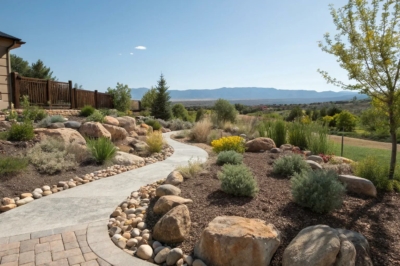1. Succulent Symphony
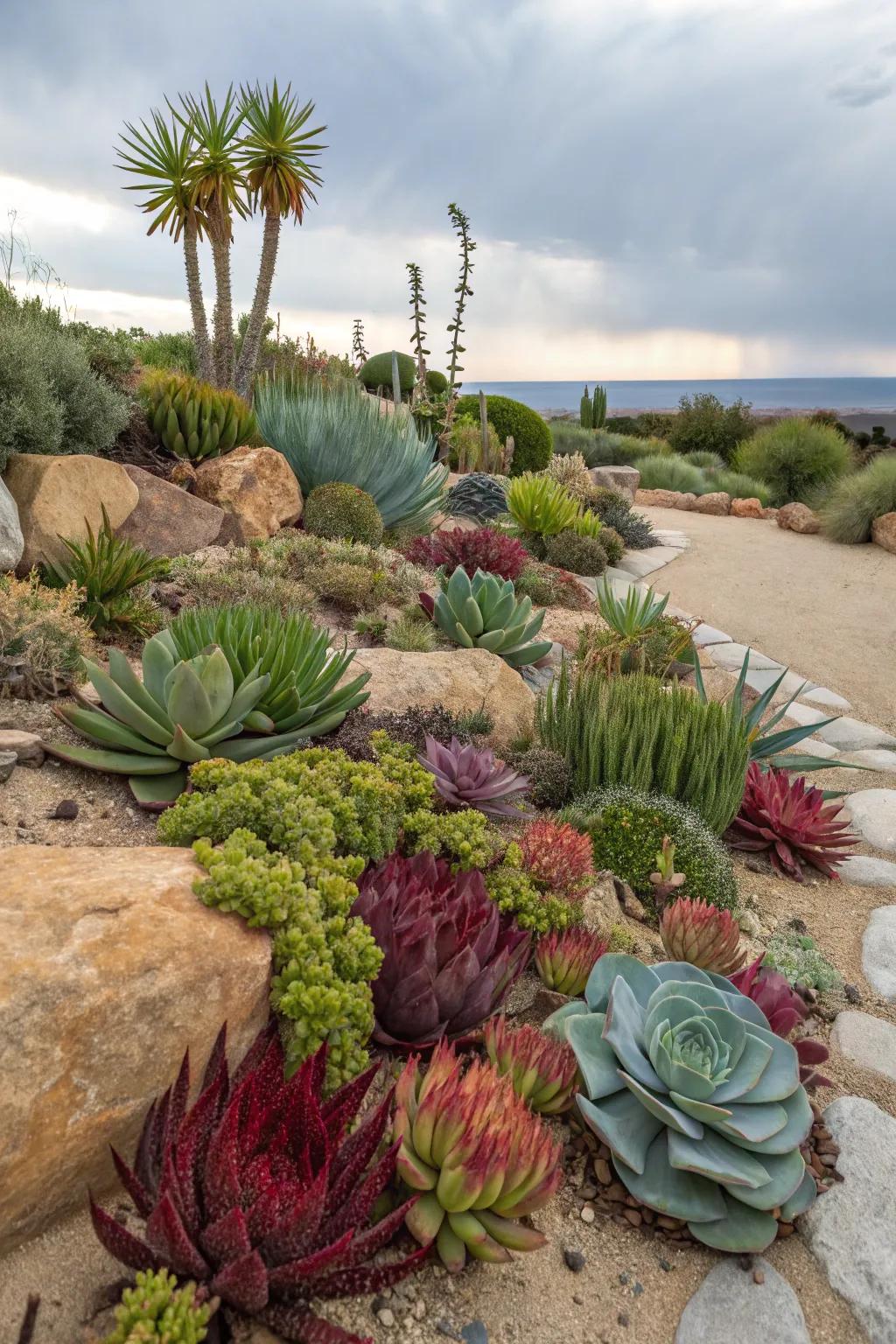
Succulents are a xeriscaper’s best friend, offering both beauty and resilience. Try mixing different shapes and colors for a vibrant display that thrives in Utah’s arid climate.
A few helpful options:
- Succulent Starter Kit: Start your succulent garden with ease using this all-in-one starter kit. Perfect for beginners.
- Drip Irrigation System: Ensure efficient watering of your succulents with a customizable drip irrigation system.
- Cactus and Succulent Soil Mix: Promote healthy growth by using this well-draining soil mix designed for cacti and succulents.
2. Rock Gardens with a Twist
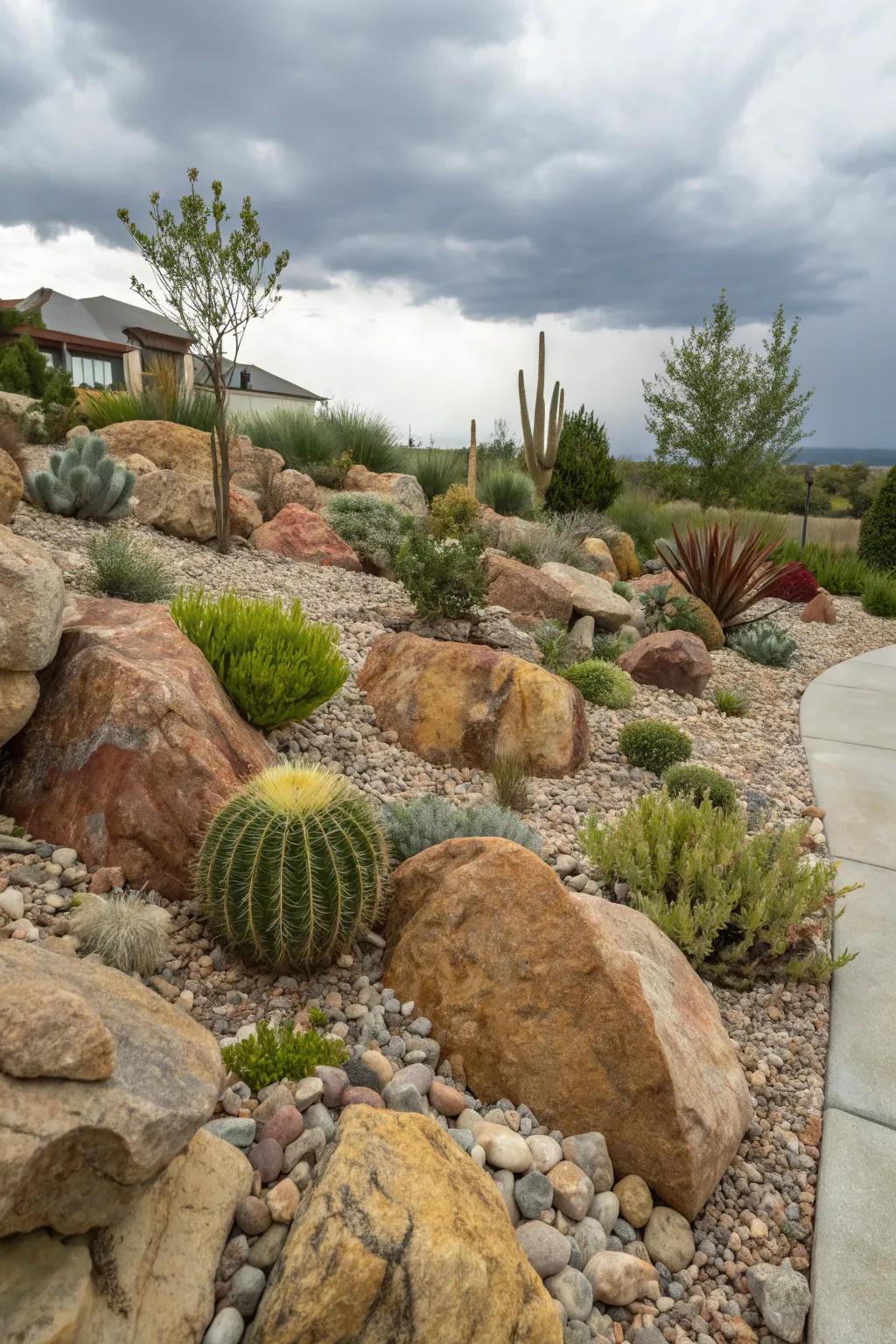
Rock gardens can be more than just a pile of stones; they’re a canvas for creativity. I love using a variety of sizes and colors to create a natural look that blends seamlessly with Utah’s rugged landscape.
You might give these a try:
- Assorted Decorative Landscape Rocks: Transform your garden with a variety of colorful rocks for a vibrant, natural appearance.
- Drought-Resistant Succulent Plants: Enhance your garden with easy-care succulents perfect for Utah’s dry climate.
- Natural Cactus Garden Kit: Add unique texture with a cactus garden kit that thrives in arid environments.
3. Artistic Driftwood Displays
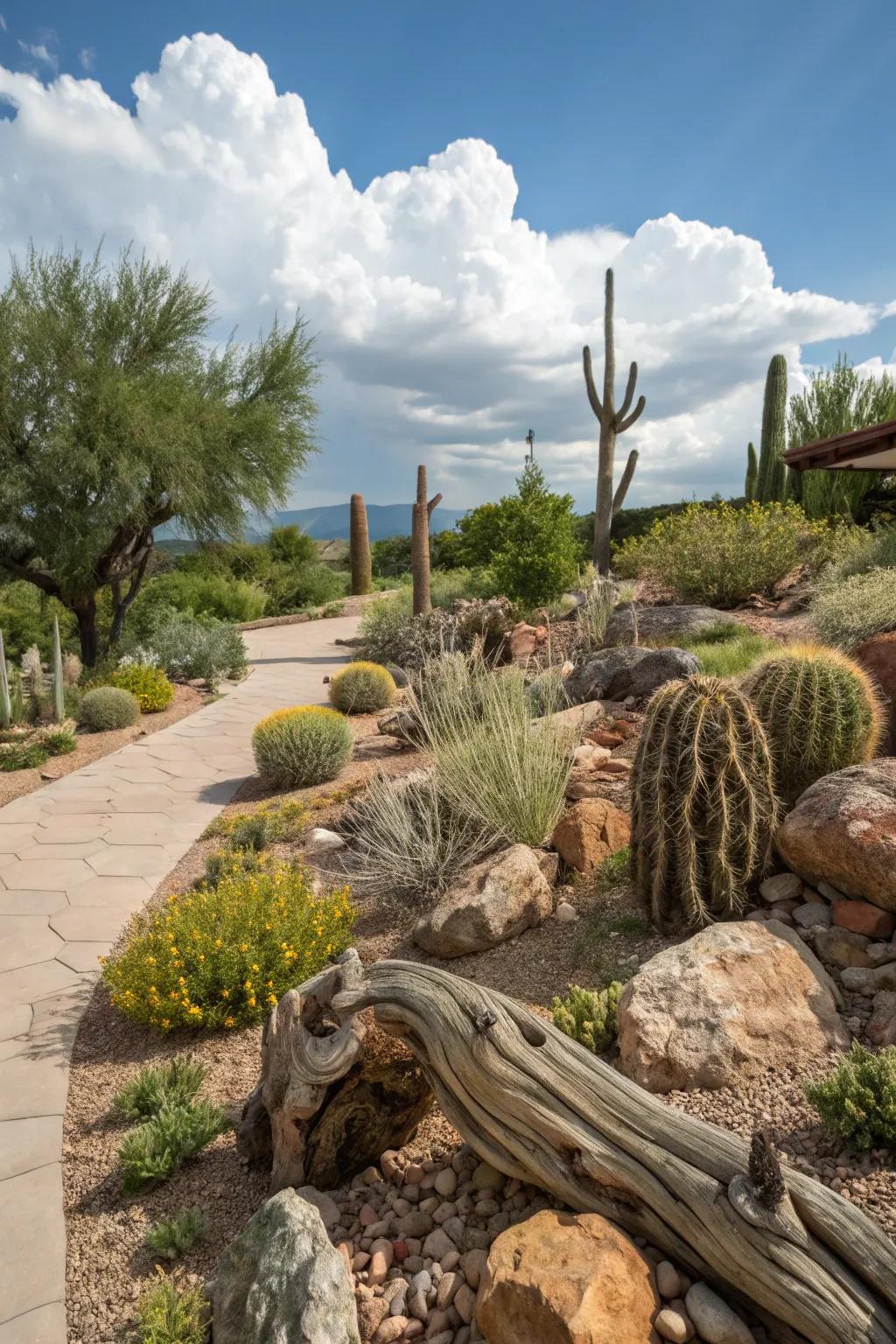
Driftwood can be sculptural and practical, adding texture and interest. I use it to define spaces and create natural art within my garden.
Consider these options:
- Natural Driftwood Pieces for Garden: Enhance your garden with natural driftwood pieces for a rustic, artistic touch.
- Weatherproof Garden Sealer: Protect your driftwood displays with a durable, weatherproof garden sealer.
- Outdoor Solar Spotlights: Highlight your driftwood art at night with eco-friendly solar spotlights.
4. Vertical Gardens
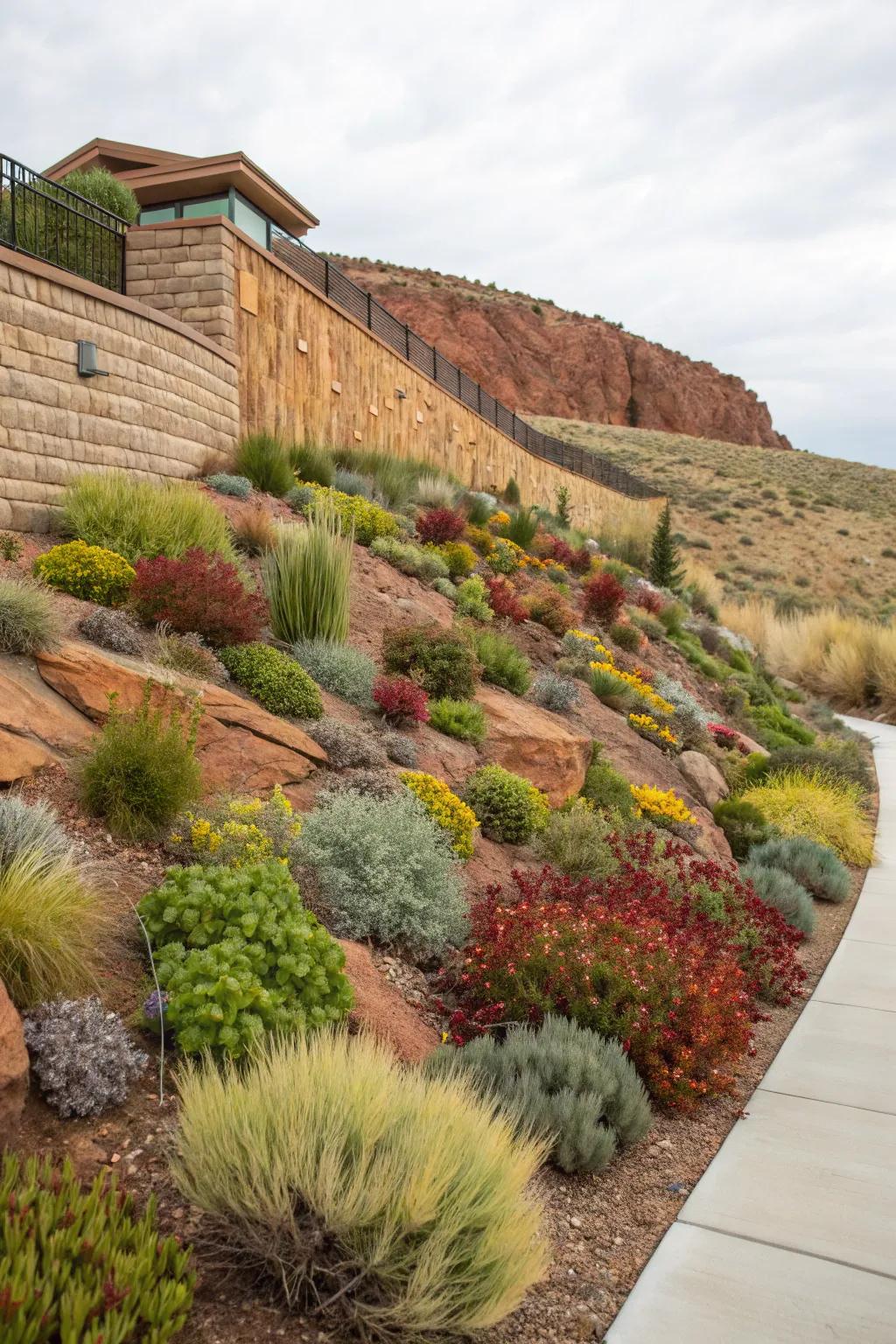
Vertical gardens are a creative solution for limited space. I love how they add greenery without occupying precious ground space.
Try these:
- Wall-Mounted Planters: Enhance your vertical garden with these sleek planters; perfect for adding greenery efficiently.
- Self-Watering Vertical Garden Kit: Simplify your gardening with a self-watering kit; ideal for maintaining lush vertical gardens.
- Hanging Wall Herb Planters: Grow fresh herbs in limited space with hanging planters; convenient for any vertical garden.
5. Minimal Turf, Maximum Impact
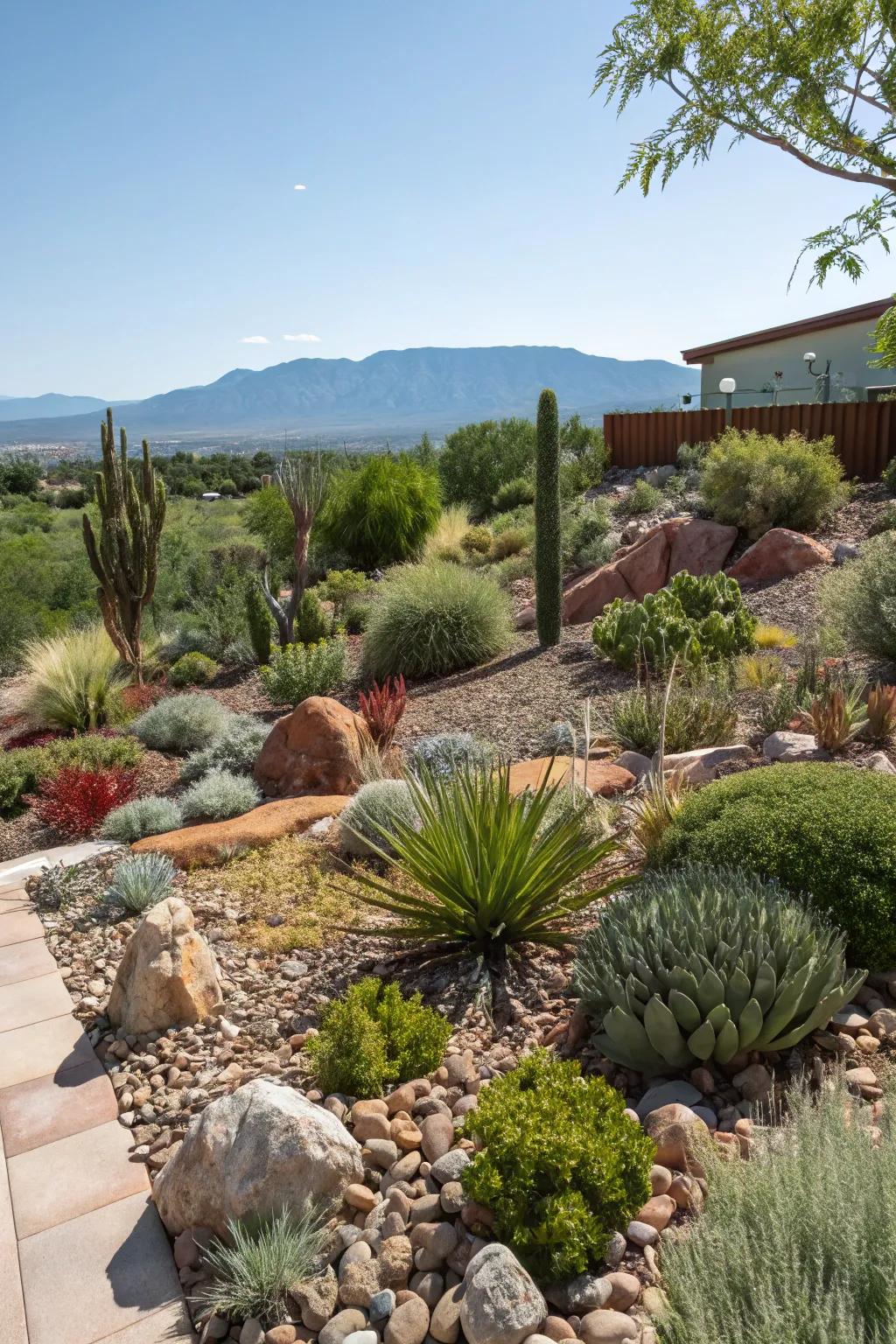
Replace traditional lawns with drought-tolerant ground covers for a fresh, eco-friendly look. My garden uses clover and thyme for a lush, green alternative.
Check these products out:
- Drought-Tolerant Ground Cover Seeds: Transform your garden effortlessly with drought-tolerant ground cover seeds for lasting green beauty.
- Eco-friendly Weed Barrier Fabric: Keep your garden pristine with this eco-friendly fabric, reducing weeds with less maintenance.
- Drip Irrigation Kit: Conserve water efficiently with a drip irrigation kit, perfect for sustainable xeriscaping practices.
6. Sculptural Plant Forms
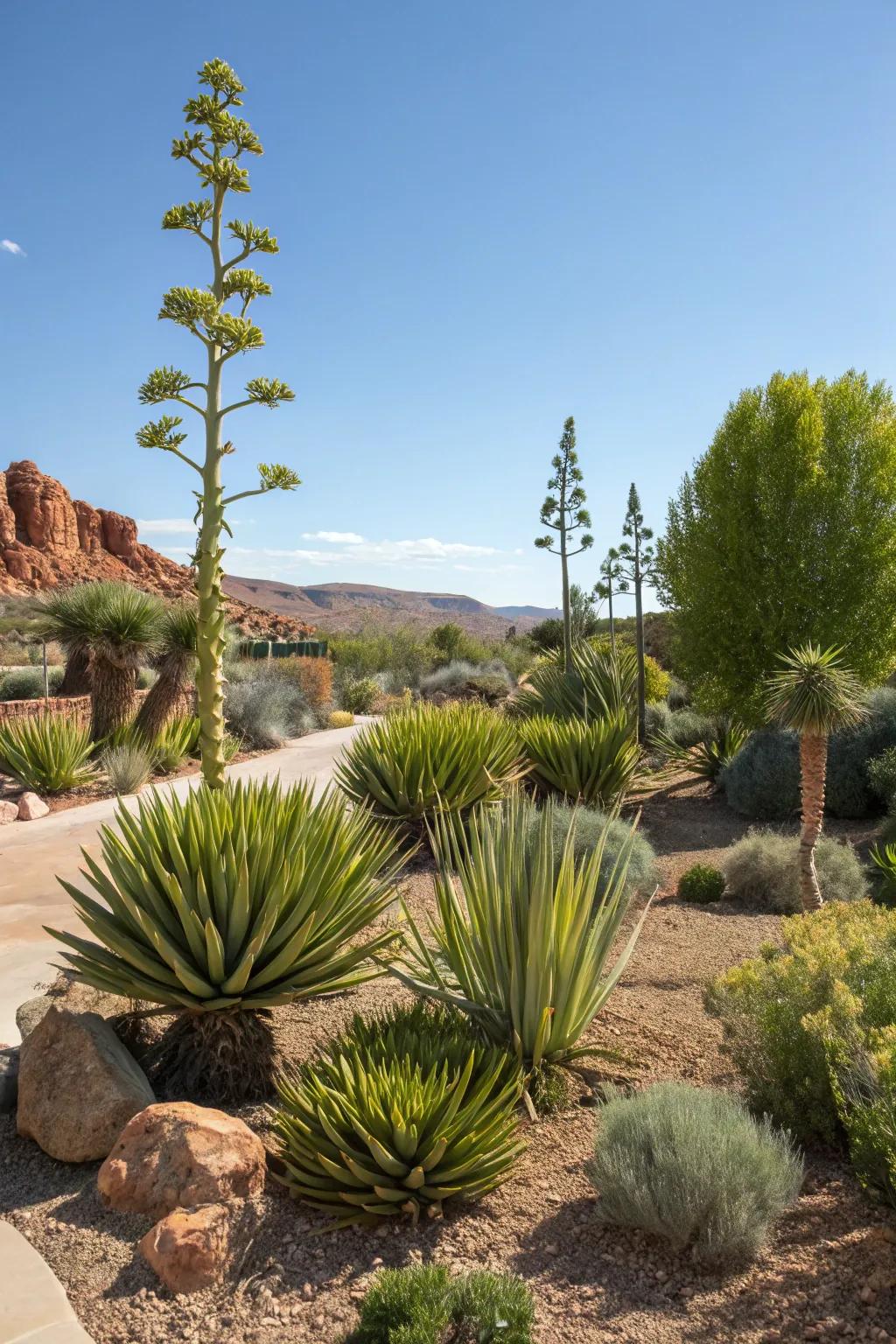
Plants with unique shapes can serve as living sculptures. I love incorporating yucca and agave for their striking forms and minimal care needs.
Might be a good match:
- Artificial Yucca Plant: Add a striking look to your garden with a low-maintenance artificial yucca plant.
- Agave Plant Seeds Kit: Grow your own agave plants with this easy-to-use seed kit for stunning garden accents.
- Decorative Outdoor Planters: Enhance your sculptural plants with stylish planters, perfect for any xeriscaping project.
7. Rainwater Harvesting
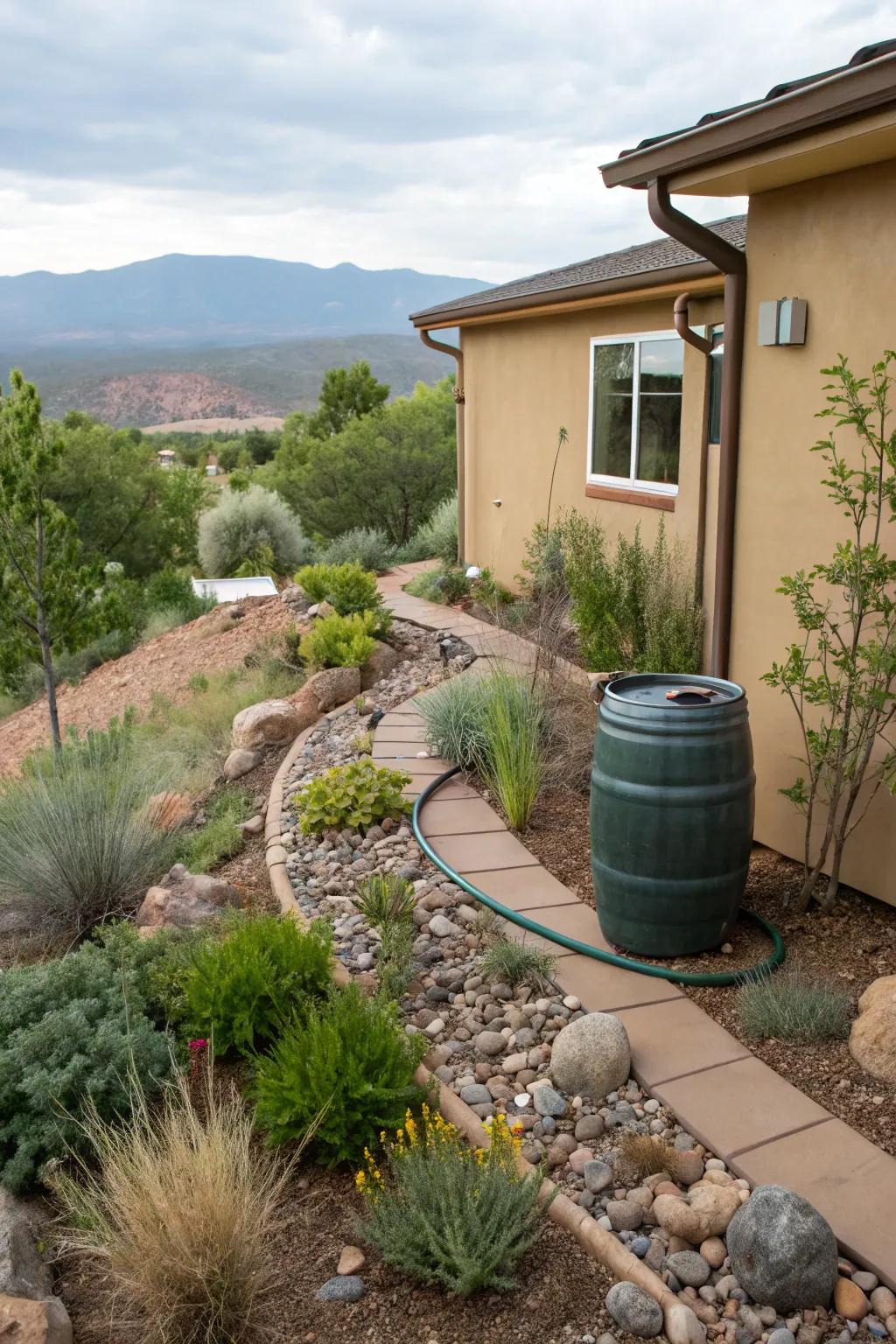
Collecting rainwater is a smart way to water your xeriscape. I use it to supplement irrigation and keep my plants happy and healthy.
Some ideas to consider:
- Rain Barrel with Spigot: Capture and store rainwater efficiently with a durable, easy-to-install rain barrel.
- Downspout Diverter Kit: Easily redirect rainwater from your gutters into your rain barrel with a diverter kit.
- Rainwater Collection Screen: Keep debris out of your rain collection system with a protective rainwater collection screen.
8. Boulder Boldness
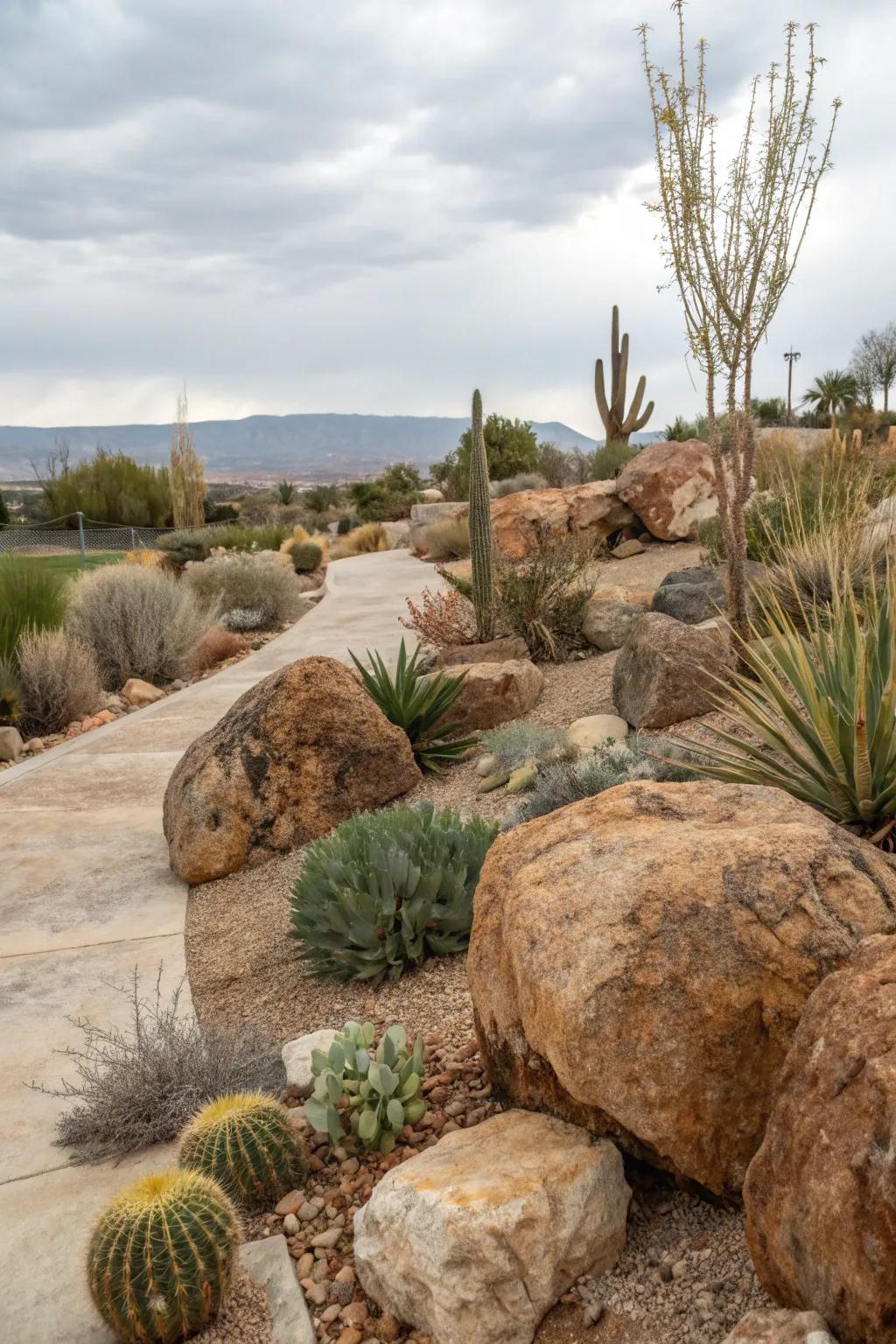
Large boulders can serve as dramatic focal points in your garden. I like to use them to create a sense of natural harmony and balance.
Useful items to consider:
- Decorative Garden Boulders: Enhance your garden’s natural beauty with realistic decorative boulders that add texture and depth.
- Drought-Resistant Plant Seeds: Plant drought-resistant seeds to complement your boulders and minimize water usage effectively.
- Outdoor Landscape Lighting: Illuminate your garden features with outdoor lighting to create a dramatic nighttime ambiance.
9. Native Plant Paradise
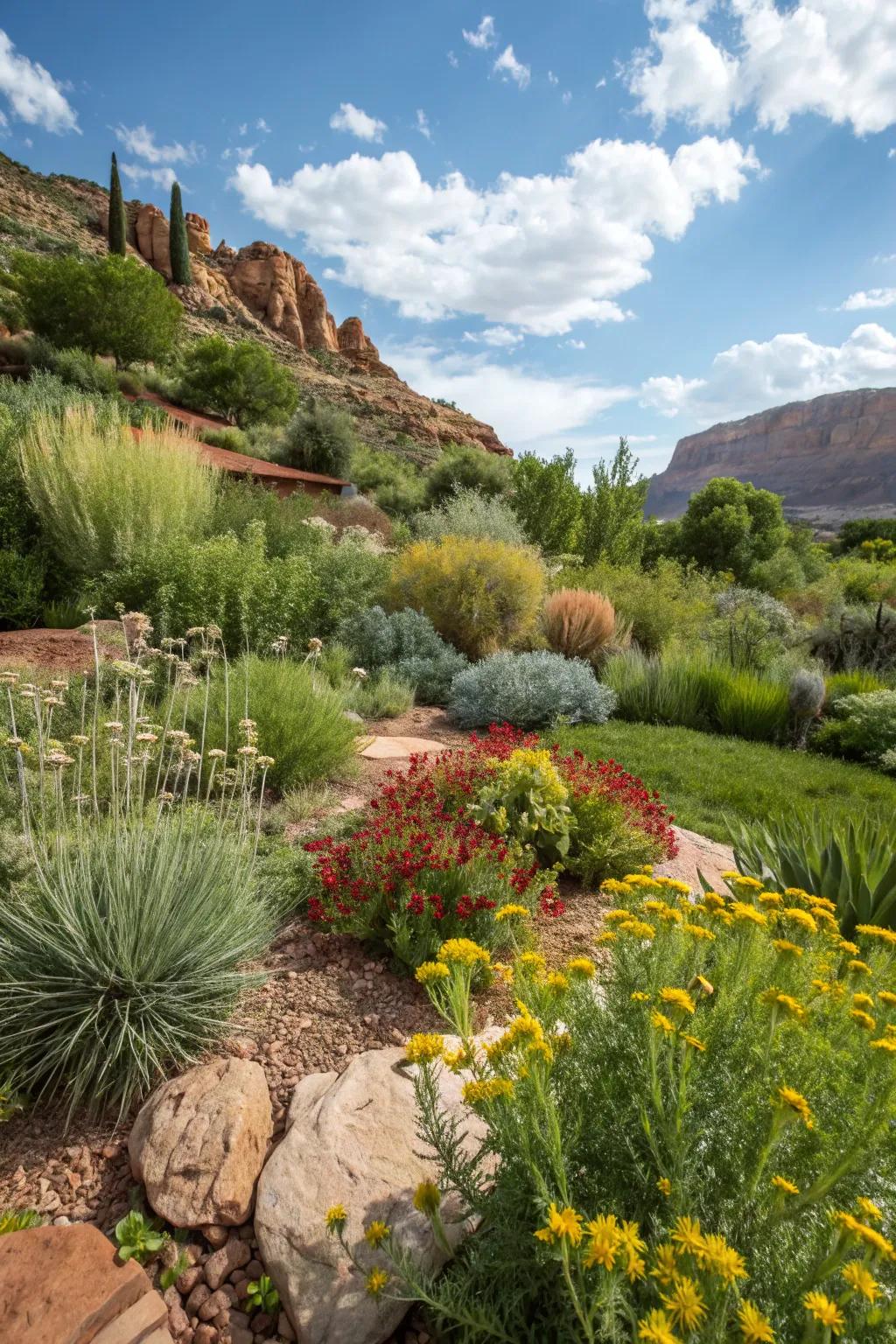
Embrace Utah’s natural beauty by incorporating native plants that require minimal water. In my experience, these plants thrive with little care and attract local wildlife.
Some handy options:
- Drought-Tolerant Plant Seeds: Transform your garden with vibrant native plant seeds that thrive in Utah’s unique climate.
- Drip Irrigation Kit: Efficiently water your native plants with a drip irrigation kit, conserving water and promoting growth.
- Organic Mulch: Enhance your garden’s health and moisture retention with quality organic mulch for native plants.
10. Colorful Gravel Mulch
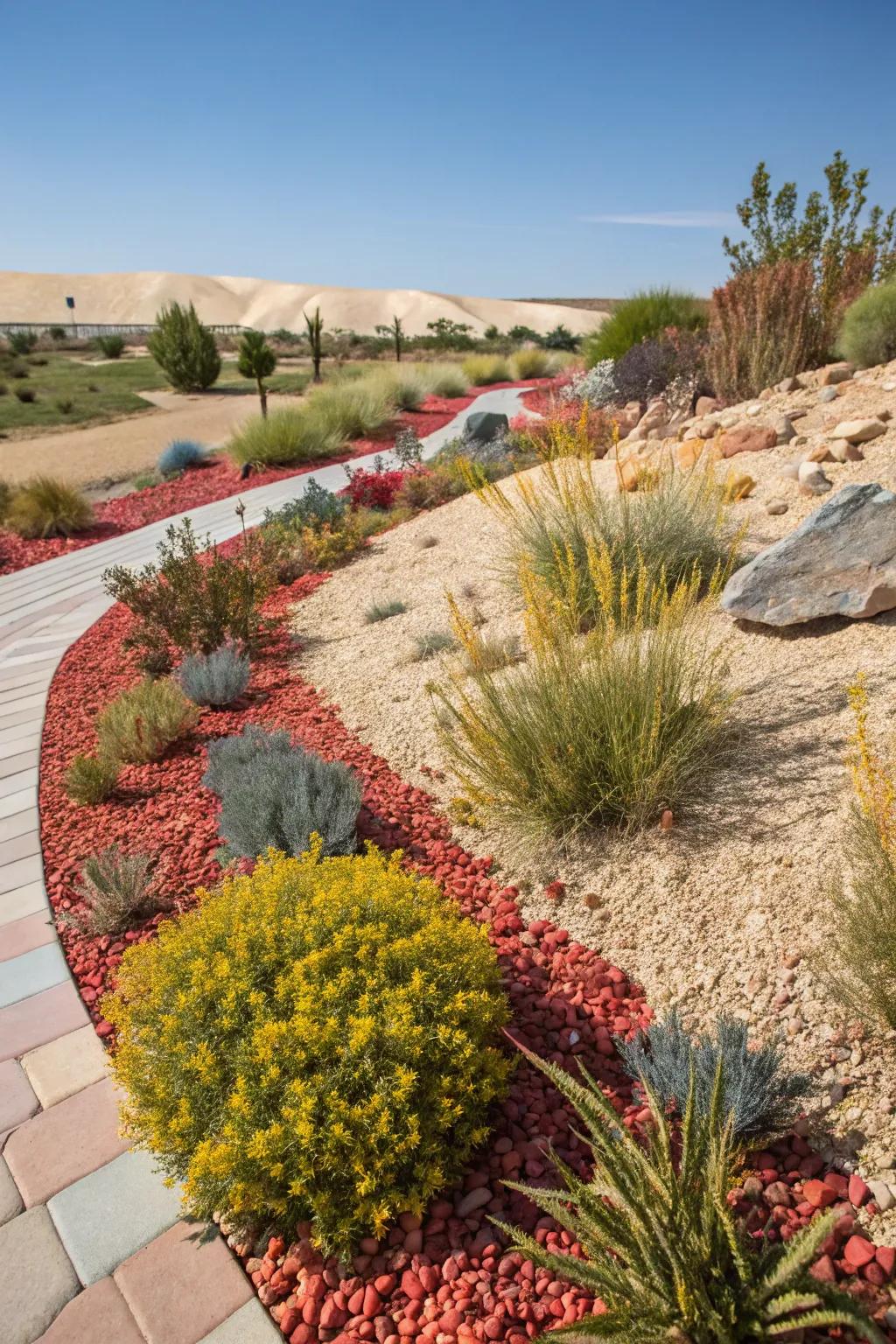
Using colorful gravel as mulch can enhance your garden’s aesthetics. I like how it contrasts with plants and adds a pop of color.
Possibly helpful picks:
- Colored Landscaping Gravel: Enhance your landscape with vibrant, durable colored gravel that adds stunning aesthetic appeal.
- Garden Weed Barrier Fabric: Prevent weed growth effortlessly while enhancing plant aesthetics in your xeriscape garden.
- Metal Landscape Edging: Define garden boundaries with sleek, flexible metal edging suitable for vibrant gravel designs.
11. Cacti and Yucca Wonders
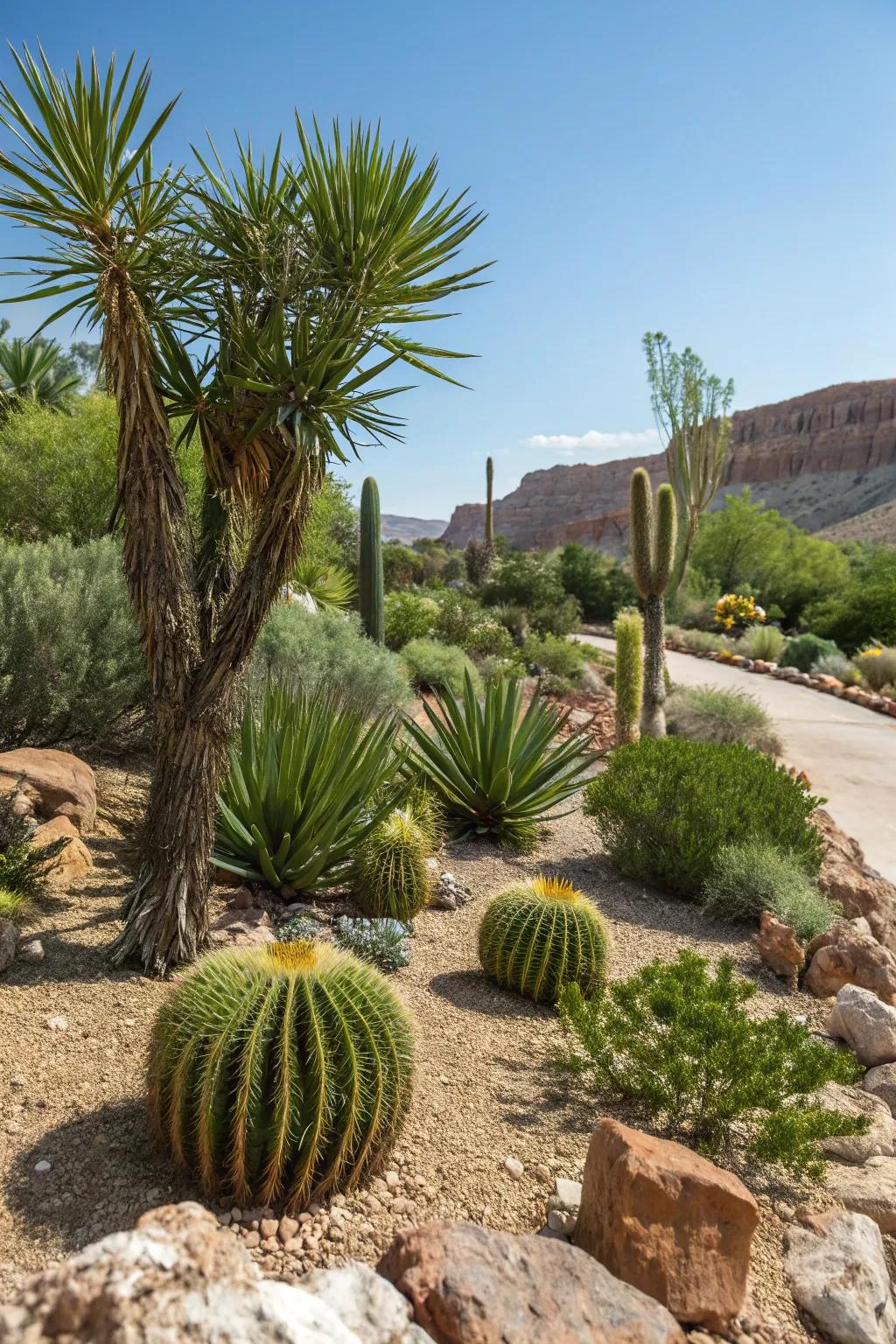
Cacti and yucca bring an exotic touch to any xeriscape. They’re incredibly low-maintenance and thrive in Utah’s climate, making them a personal favorite.
Products that could assist:
- Cactus and Succulent Soil Mix: Ensure your cacti thrive with this well-draining soil mix designed for optimal growth conditions.
- Drip Irrigation Kit: Simplify watering with an easy-to-install drip irrigation kit suitable for cacti and yucca.
- Decorative Garden Rocks: Enhance your xeriscape design by adding decorative rocks for a natural, polished look.
12. Stone Pathway Delight
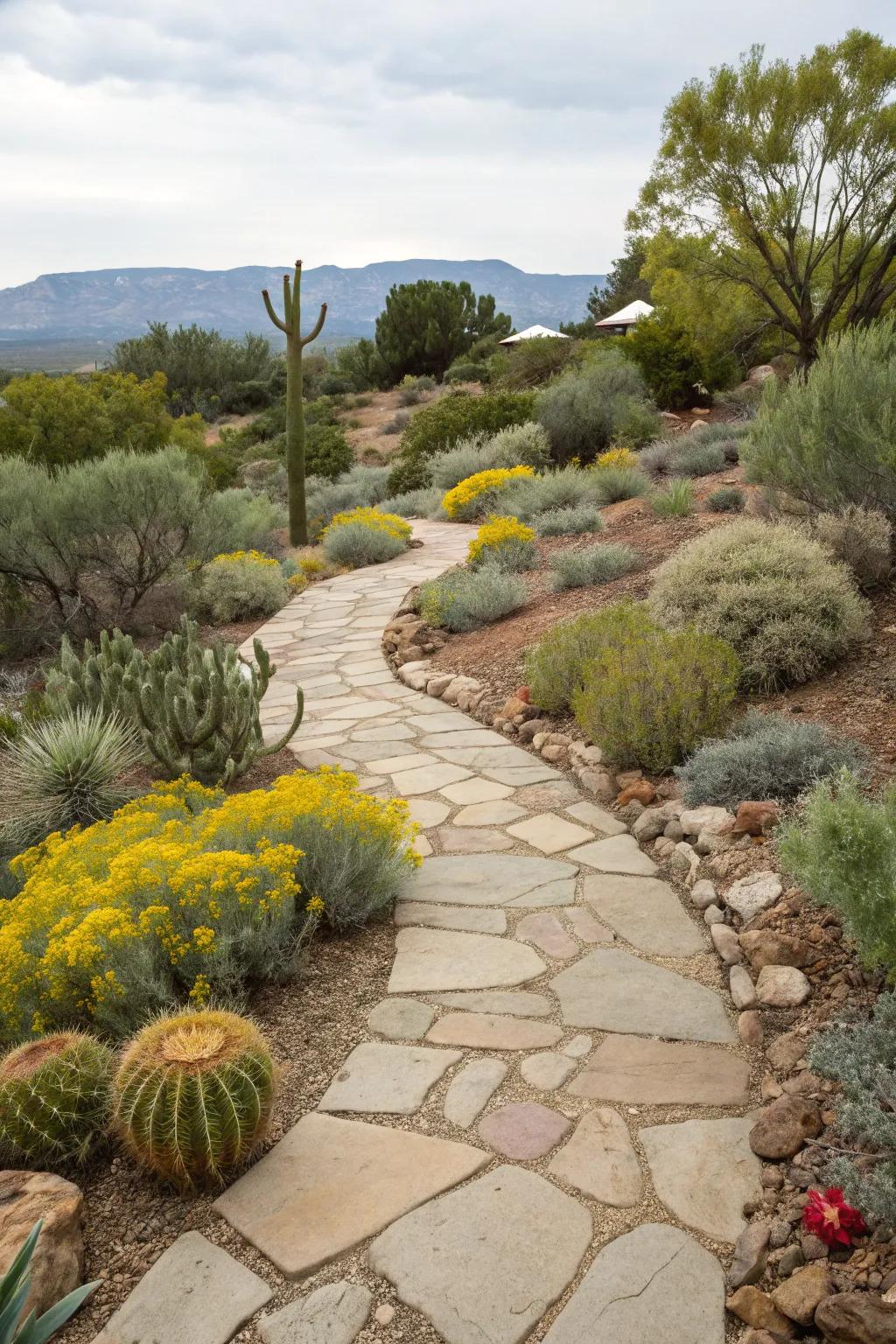
Creating stone pathways not only adds structure to your garden but also reduces water usage. I enjoy designing winding paths that invite exploration and relaxation.
Check if these fit your needs:
- Outdoor Stepping Stones: Enhance your garden with decorative stepping stones, adding charm and structure effortlessly.
- Landscape Fabric: Prevent weed growth and improve drainage by installing durable landscape fabric under pathways.
- Pathway Solar Lights: Illuminate your garden paths with solar lights, creating a charming evening ambiance.
13. Terraced Beauty
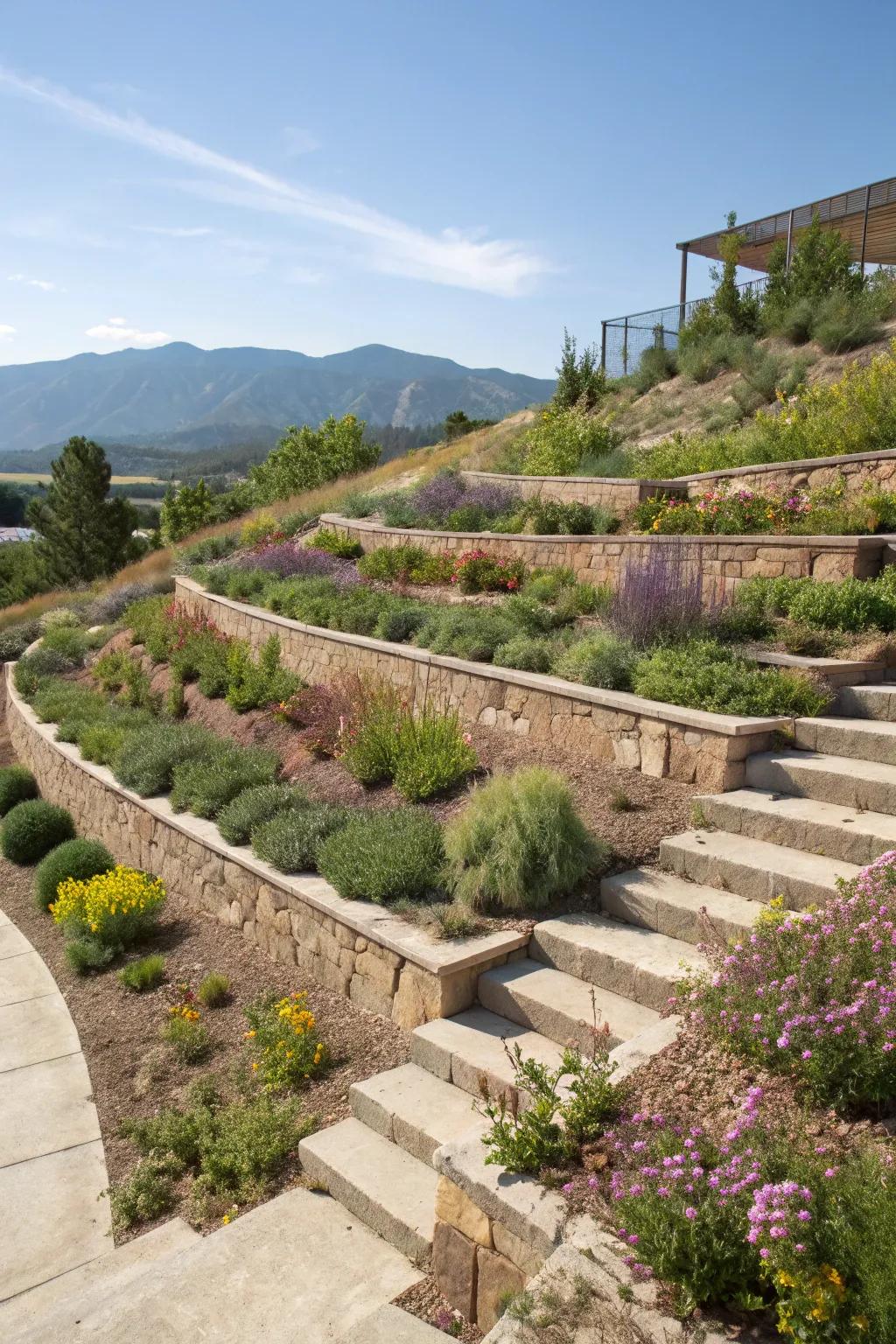
Terracing can transform a sloped yard into a functional and beautiful space. I love the added dimension and interest it brings to any garden.
A few suggestions:
- Landscape Retaining Wall Blocks: Transform your sloped yard with sturdy retaining wall blocks, adding depth and elegance effortlessly.
- Drought-Resistant Plant Seeds: Beautify your terraced garden with drought-tolerant plant seeds perfect for sustainable landscaping.
- Automatic Drip Irrigation Kit: Ensure efficient watering for your terraces with an easy-to-install drip irrigation system.
14. Desert-Inspired Seating Areas
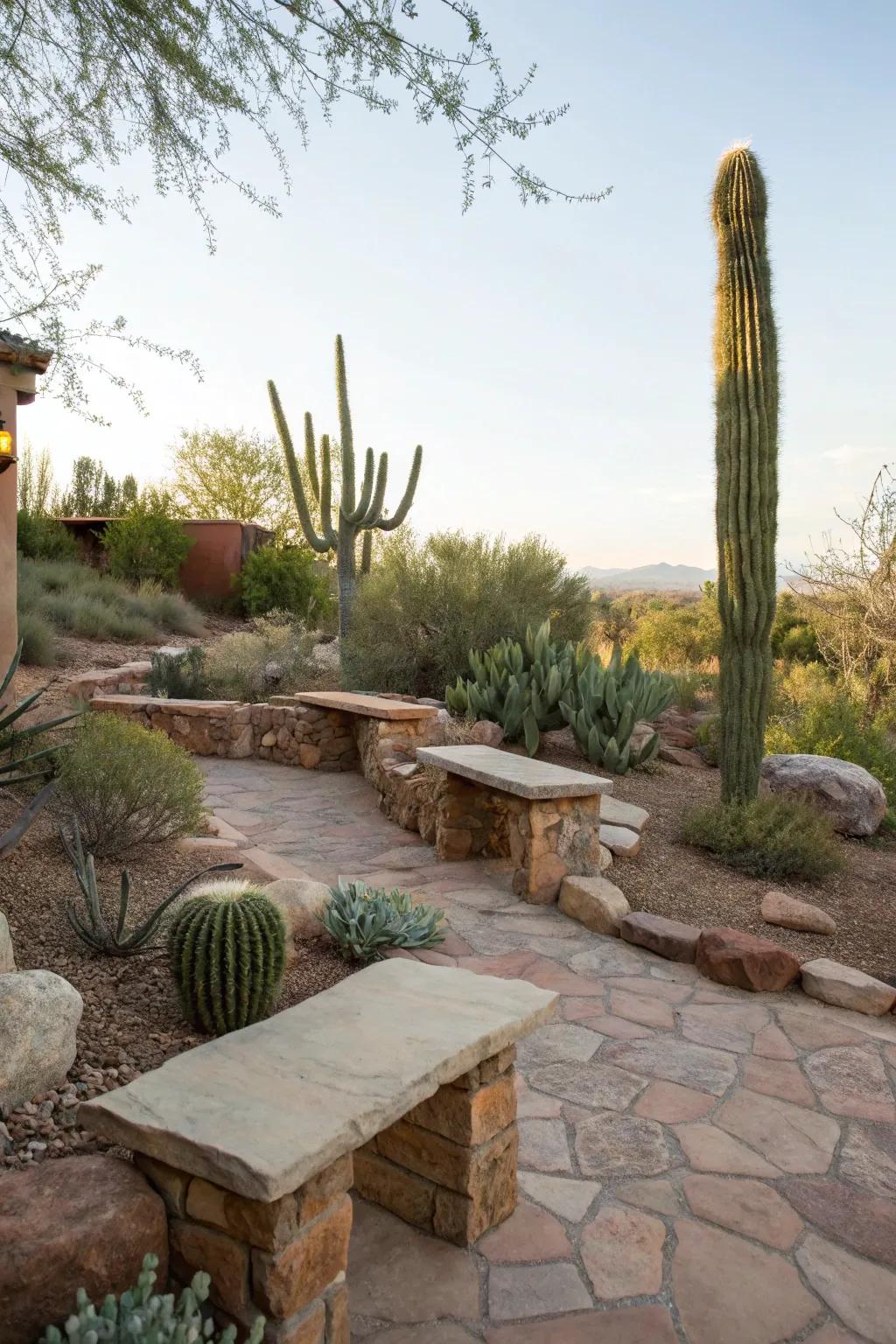
Create a cozy seating area using natural materials. I find that stone benches or wooden furniture blend beautifully into a xeriscape setting.
These products might be useful:
- Natural Stone Bench: Enhance your garden with a durable stone bench that complements a desert landscape effortlessly.
- Rustic Wooden Outdoor Chair: Add rustic charm to your seating area with a sturdy wooden chair for a cozy setting.
- Weatherproof Outdoor Cushion Set: Maximize comfort in your outdoor oasis with weatherproof cushions perfect for desert conditions.
15. Subtle Water Features
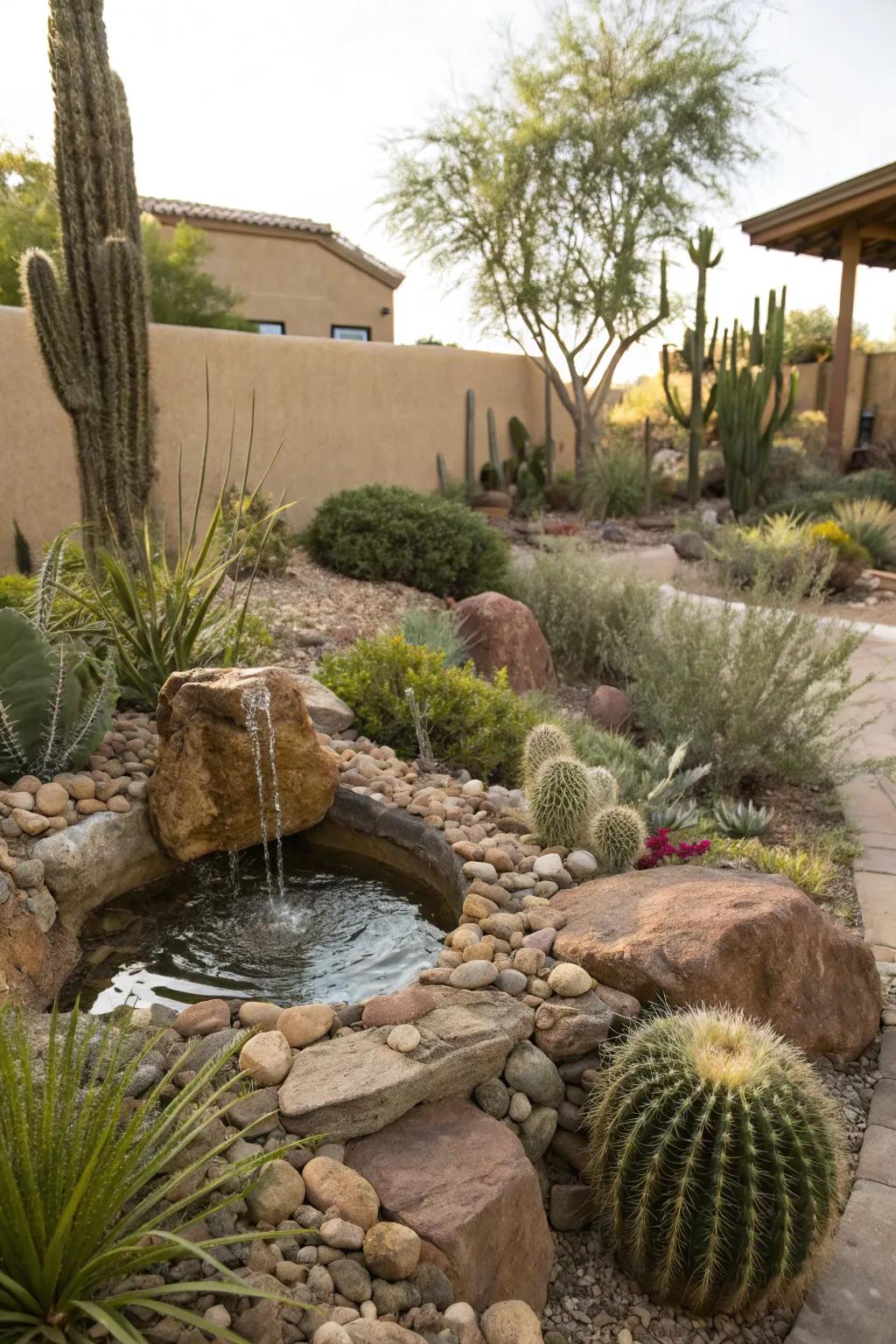
A small water feature can add serenity without wasting water. In my garden, a simple fountain creates a relaxing atmosphere with minimal upkeep.
Possibly handy products:
- Solar-Powered Water Fountain Pump: Enhance your garden’s tranquility with this eco-friendly, solar-powered fountain pump. Easy and efficient.
- Small Rock Waterfall Fountain Kit: Add a natural touch to your garden with this easy-to-install rock waterfall kit.
- Water Feature LED Lights: Illuminate your water feature with these energy-efficient LED lights. Enhance ambiance beautifully.
16. Shade Structures
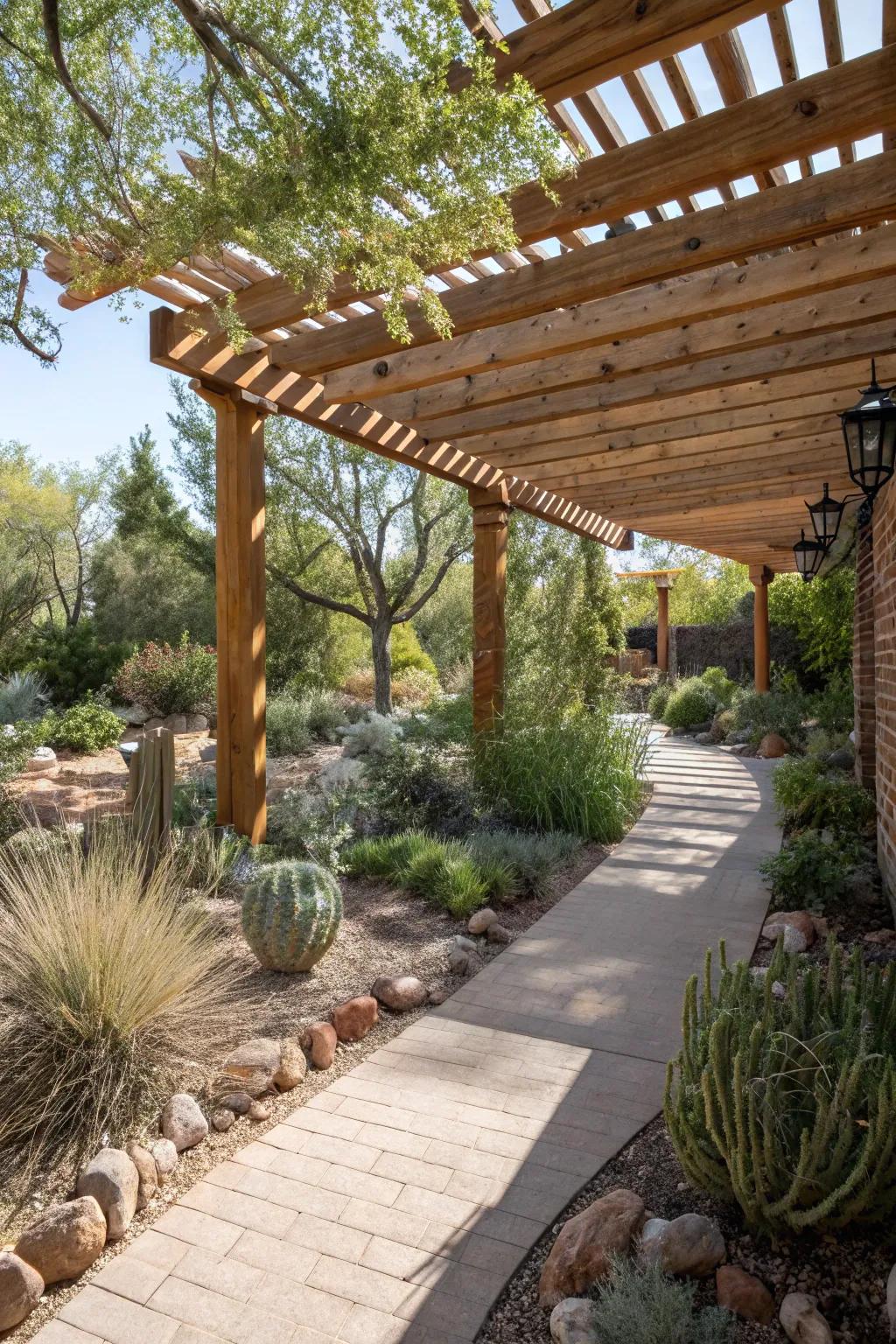
Incorporate shade structures to protect plants from the harsh sun. Pergolas or trellises not only provide relief but also add vertical interest.
May just do the trick:
- Wooden Pergola Kit: Install a wooden pergola to create natural shade and enhance your garden’s vertical appeal.
- Garden Trellis Panels: Use trellis panels to protect delicate plants and add vertical interest to your space.
- Outdoor Shade Sail Canopy: Add an outdoor shade sail canopy for versatile sun protection and stylish garden design.
17. Mulch Magic
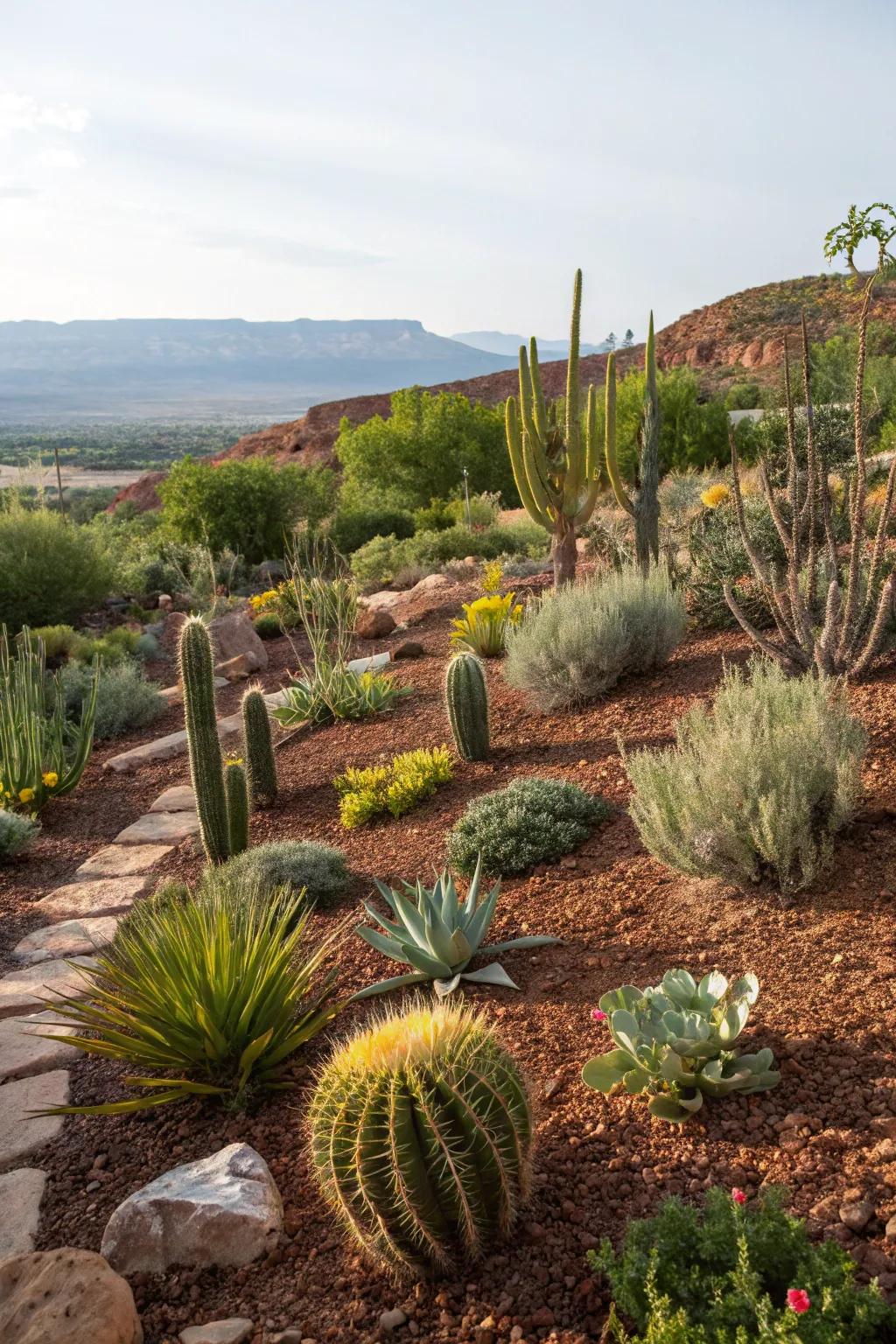
Mulch is a gardener’s secret weapon against weeds and water loss. I recommend using organic mulch to keep the soil cool and retain moisture.
A few choices to try:
- Organic Mulch Chips: Enhance your garden’s moisture retention and weed control with eco-friendly organic mulch chips.
- Cedar Mulch: Boost soil health and deter pests naturally with aromatic cedar mulch for your xeriscape.
- Bark Mulch: Create a natural look while preserving soil moisture with high-quality organic bark mulch.
18. Edible Xeriscaping
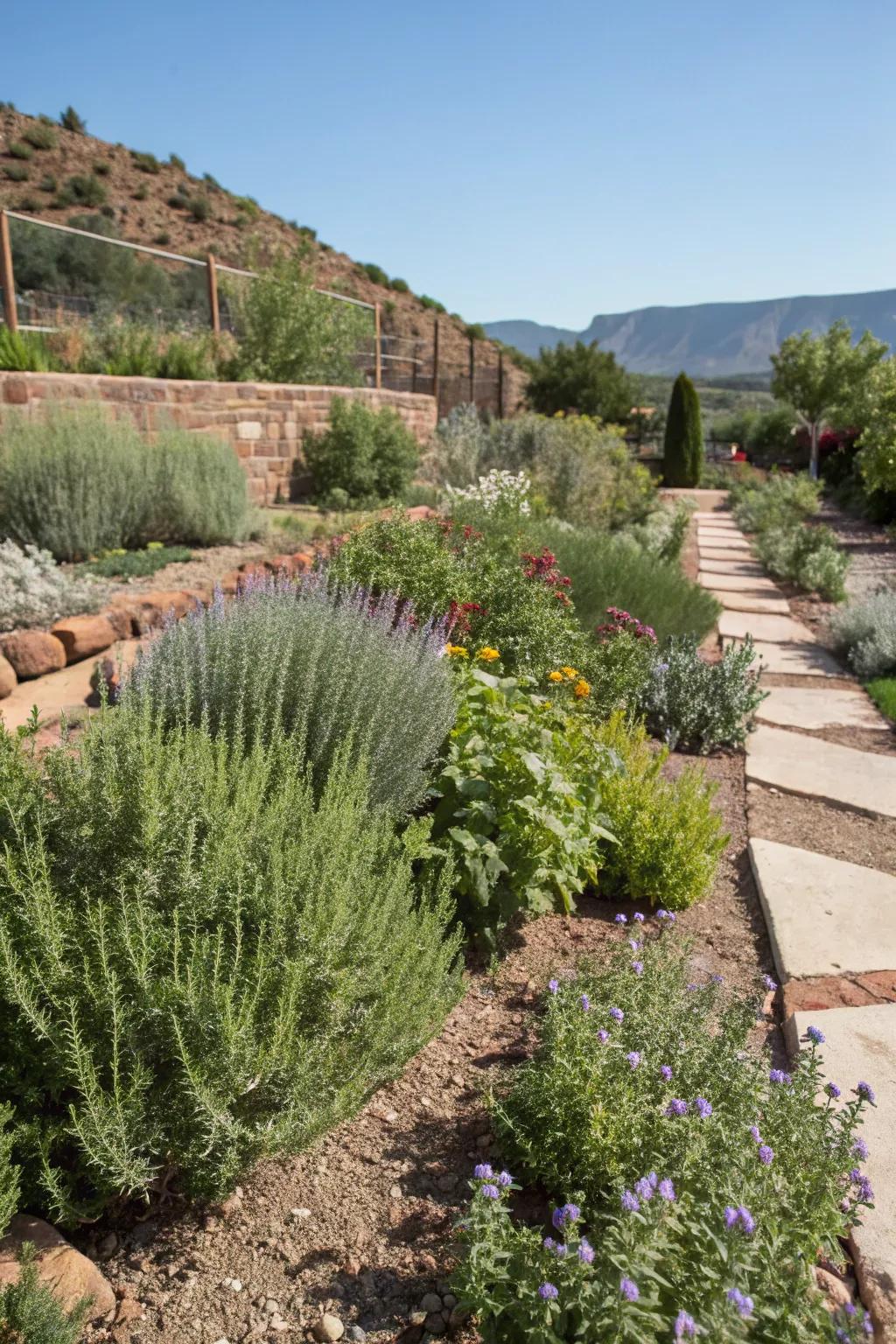
Combine beauty and utility by planting drought-tolerant edibles. I enjoy growing herbs like rosemary and sage that thrive with little water.
A few relevant products:
- Drought-Tolerant Herb Seeds Variety Pack: Kickstart your xeriscaping with these herb seeds, perfect for beautiful and sustainable gardens.
- Self-Watering Planters: Enhance your garden’s efficiency with self-watering planters, reducing daily maintenance needs.
- Natural Mulch for Water Retention: Improve soil moisture with this natural mulch, ideal for sustainable edible xeriscaping.
19. Raised Bed Revelations
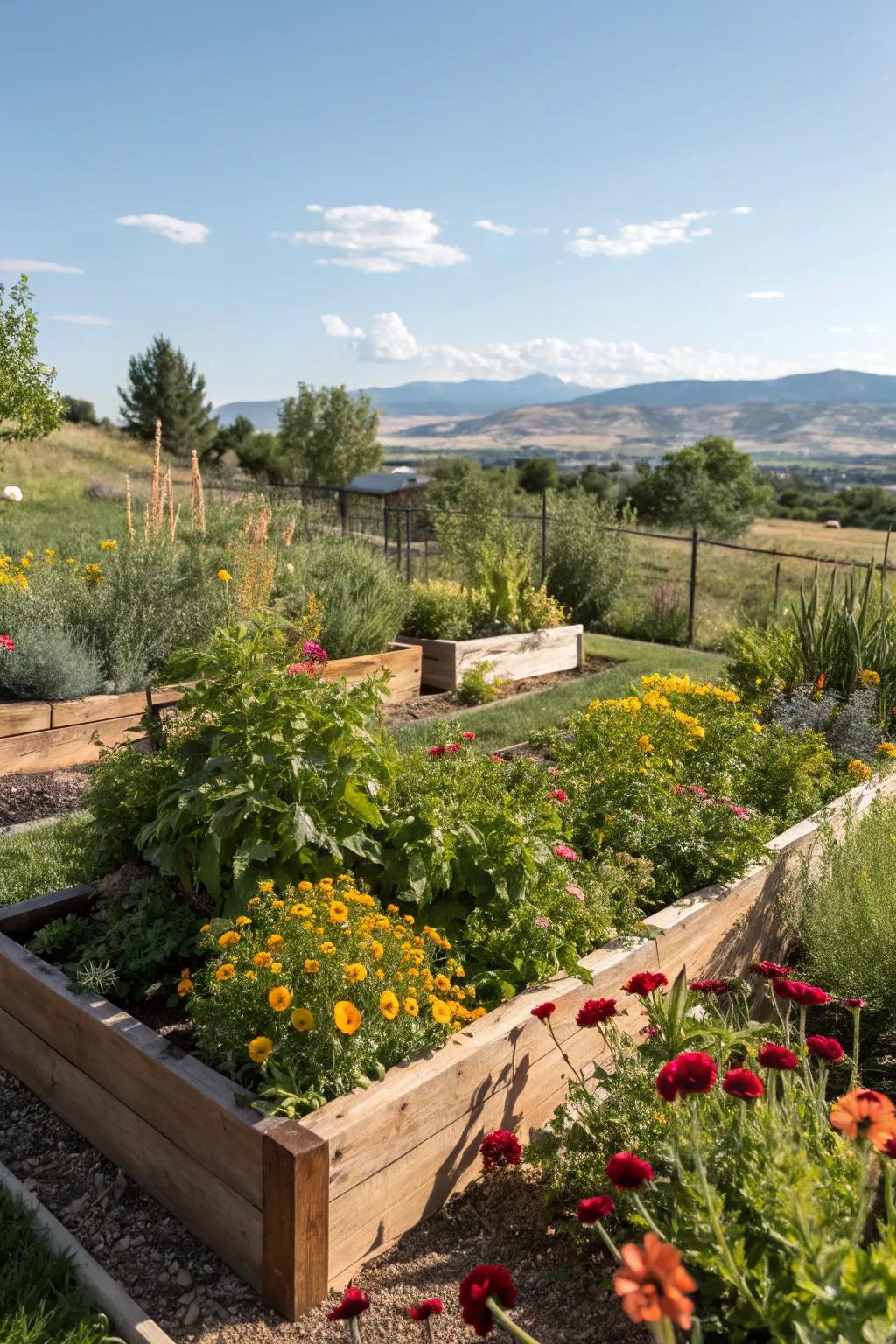
Raised beds offer better drainage and a tidy appearance. They’re perfect for growing veggies or showcasing favorite plants in my xeriscape.
Items that may come in handy:
- Wooden Raised Garden Bed Kit: Elevate your gardening with a durable raised bed kit, perfect for veggies and xeriscaping plants.
- Planter Bed Soil Mix: Ensure optimal drainage and growth with this specially formulated soil mix for raised beds.
- Drip Irrigation Kit for Raised Beds: Simplify watering with an easy-to-install drip irrigation system designed for raised garden beds.
20. Wildflower Meadows
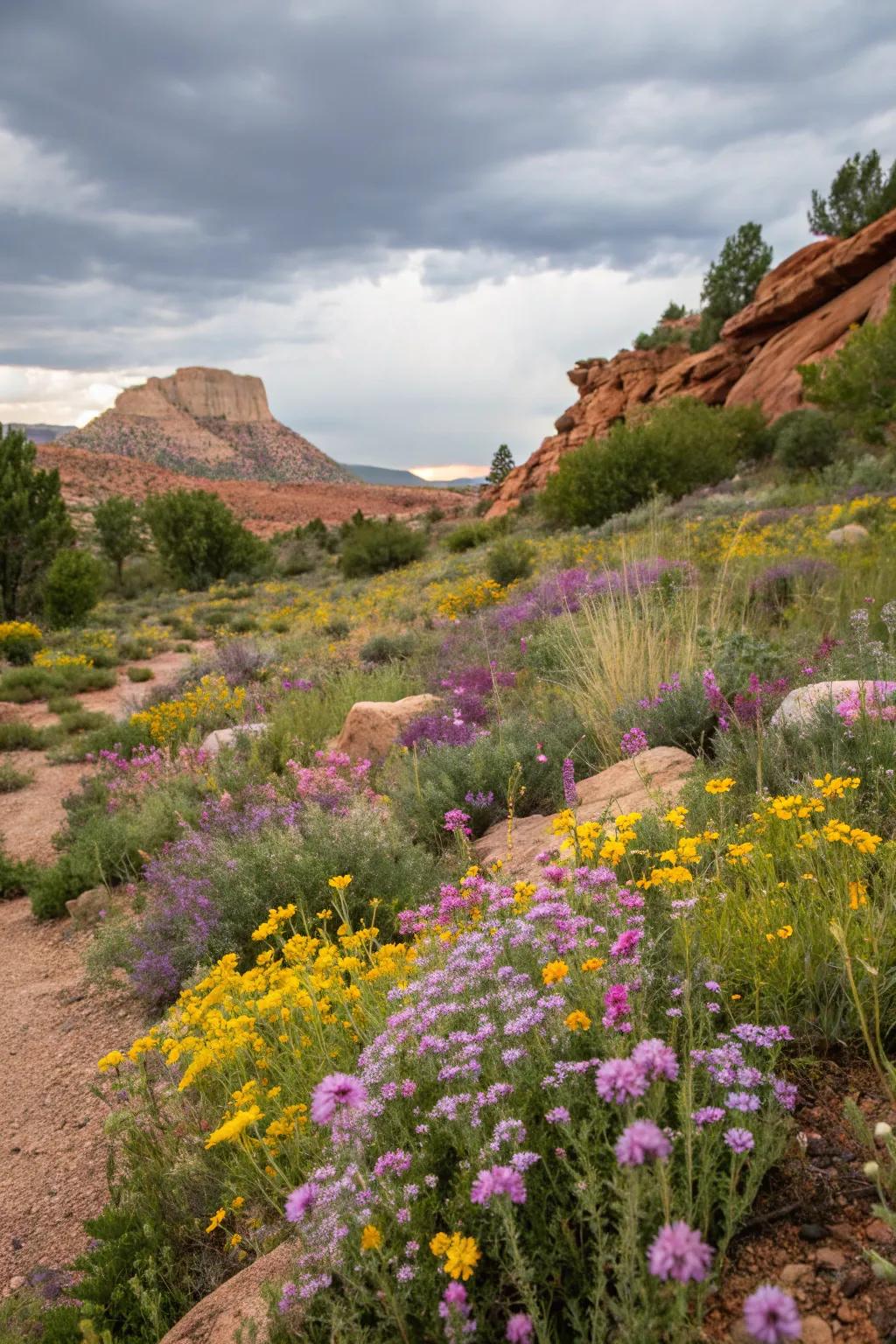
Wildflowers bring color and life to xeriscapes, attracting pollinators and birds. In my experience, they create a vibrant, ever-changing landscape.
Give these a look:
- Wildflower Seed Mix for Xeriscaping: Create a colorful wildflower meadow with seeds designed for Utah’s dry climate. Perfect for pollinators!
- Pollinator-Friendly Garden Book: Discover tips for attracting pollinators to your wildflower meadow. Enhance biodiversity with ease.
- Garden Mulch for Xeriscapes: Conserve water and protect your wildflowers with natural mulch. Ideal for dry landscapes.
